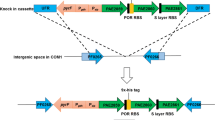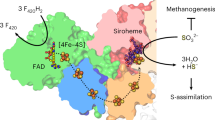Abstract
The localization of the dissimilatory sulfite reductase in Desulfovibrio desulfuricans strain Essex 6 was investigated. After treatment of the cells with lysozyme, 90% of the sulfite reductase activity was found in the membrane fraction, compared to 30% after cell rupture with the French press. Sulfite reductase was purified from the membrane (mSiR) and the soluble (sSiR) fractiion. On SDS-PAGE, both mSiR and sSiR exhibited three bands at 50, 45 and 11 kDa, respectively. From their UV/VIS properties (distinct absorption maxima at 391, 410, 583, 630 nm, enzymes as isolated) and the characteristic red fluorescence in alkaline solution, mSiR and sSiR were identified as desulfoviridin. Sulfite reductase (HSO3 -→H2S) activity was reconstituted by coupling of mSiR to hydrogenase and cytochrome c 3 from D. desulfuricans. The specific activity of mSiR was 103 nmol H2 min-1 mg-1, and sulfide was the major product (72% of theoretical yield). No coupling was found with sSiR under these conditions. Furthermore, carbon monoxide was used to diferentiate between the membrane-bound and the soluble sulfite reductase. In a colorimetric assay, with photochemically reduced methyl viologen as redox mediator, CO stimulated the activity of sSiR significantly. CO had no effect in the case of mSiR. These studies documented that, as isolated, both forms of sulfite reductase behaved differently in vitro. Clearly, in D. desulfuricans, the six electron conversion HSO3 -→H2S was achieved by a membranebound desulfoviridin without the assistance of artificial redox mediators, such as methyl viologen.
Similar content being viewed by others
Abbreviations
- SiR :
-
sulfite reductase
- mSiR :
-
sulfite reductase purified from membranes
- sSiR :
-
sulfite reductase purified from the soluble fraction
References
Akagi JM (1981) Dissimilatory sulfate reduction, mechanistic aspects. In: Bothe H, Trebst A (eds) Biology of inorganic nitrogen and sulfur, Springer, Berlin Heidelberg New York, pp 174–187
Badziong W, Thauer RK (1980) Vectorial electron transport in Desulfovibrio vulgaris (Marburg) growing on hydrogen plus sulfate as sole energy source. Arch Microbiol 125:167–174
Beinert H (1983) Semi-micro methods for analysis of labile sulfide plus sulfane sulfur in unusually stable iron-sulfur proteins. Anal Biochem 131:373–378
Beinert H, Orme-Johnson WH, Palmer G (1978) Special techniques for the preparation of samples of low-temperature EPR spectroscopy. Methods Enzymol 54:111–150
Bruschi M, Hatchikian EC, LeGall J, Moura JJG, Xavier AV (1976) Purification, characterization and biological activity of three forms of ferredoxin from the sulfate-reducing bacterium Desulfovibrio gigas. Biochem Biophys Acta 449:275–284
Chen L, Liu M-Y, LeGall J (1993) Isolation and characterization of flavoredoxin, a new flavoprotein that permits in vitro reconstitution of an electron transfer chain from molecular hydrogen to sulfite reduction in the bacterium Desulfovibrio gigas. Arch Biochem Biophys 303:44–50
Cypionka H (1987) Uptake of sulfate, sulfite and thiosulfate by proton-anion symport in Desulfovibrio desulfuricans. Arch Microbiol 148:144–149
Cypionka H, Pfennig N (1986) Growth yields of Desulfotomaculum orientis with hydrogen in chemostat culture. Arch Microbiol. 143:396–399
DerVartanian DV, LeGall J (1974) A mononuclear electron transfer chain: structure and function of cytochrome c 3. Biochem Biophys Acta 346:79–99
Drake HL, Akagi JM (1978) Dissimilatory reduction of bisulfite by Desulfovibrio vulgaris. J Bacteriol 136:916–923
Fauque GD, Moura JJG, Xavier AV, Galiano N, LeGall J (1987) Isolation and characterization of a rubredoxin and a flavodoxin from Desulfovibrio desulfuricans Berre-Eau. FEBS Letters 215:63–67
Fitz RM, Cypionka H (1989) A study on electron transport-driven proton translocation in Desulfovibrio desulfuricans. Arch Microbiol 152:369–376
Fitz RM, Cypionka H (1990) Formation of thiosulfate and trithionate during sulfite reduction by washed cells of Desulfovibrio desulfuricans. Arch Microbiol 154:400–406
Fitz RM, Cypionka H (1991) Generation of a proton gradient in Desulfovibrio vulgaris. Arch Microbiol 155:444–448
Fogo JK, Popowsky M (1949) Spectrophotometric determination of hydrogen sulfide. Methylene blue method. Anal Chem 21: 732–734
Heukeshoven J, Dernick R (1985) Simplified method for silver staining of proteins in polyacrylamide gels and mechanism of silver staining. Electrophoresis 6:103–108
Jones HE, Skyring GW (1975) Effects of enzymic assay conditions on sulfite reduction catalysed by desulfoviridin from Desulfovibrio gigas. Biochem Biophys Acta 377:52–60
Karkhoff-Schweizer R, Bruschi M, Voordouw G (1993) Expression of the gamma-subunit gene of desulfoviridin-type dissimilatory sulfite reductase and of the α-and β-subunit genes is not coordinately regulated. Eur J Biochem 211:501–507
Kobayashi K, Seki Y, Ishimoto M (1974) Biochemical studies on sulfate-reducing bacteria. XIII. Sulfite reductase from Desulfovibrio vulgaris-mechanism of trithionate thiosulfate and sulfide formation and enzymatic properties. J Biochem 65: 155–157
Kremer DR, Veenhuis M, Fauque G, Peck HD, LeGall J, Lampreia J, Moura JJG, Hansen TA (1988) Immunocytochemical localization of APS reductase and bisulfite reductase in three Desulfovibrio species. Arch Microbiol 150:296–301
Laemmli UK (1970) Cleavage of structural proteins during the assembly of the head of bacteriophage T4. Nature 227:680–685
Lee JP, Peck HD (1971) Purification of the enzyme reducing bisulfite to trithionate and its identification as desulfoviridin. Biochem Biophys Res Commun 45:583–589
Massey V, Hemmerich P (1978) Photoreduction of flavo-proteins and other biological compounds catalysed by deazaflavins. Biochemistry 17:9–17
Mayhew SG (1978) The redox potential of dithionite and SO2 - from equilibrium reactions with flavodoxins, methylviologen and hydrogen plus hydrogenase. Eur J Biochem 85:535–547
Murphy MJ, Siegel LM, Kamin H, DerVartanian DV, Lee J, LeGall J, Peck HD (1973) An iron tetrahydroporphyrin prosthetic group common to both assimilatory and dissimilatory sulfite reductases. Biochem Biophys Res Commun 54:82–88
Odom JM, Peck HD (1981) Hydrogen cycling as a general mechanism for energy coupling in the sulfate reducing bacteria, Desulfovibrio sp. FEMS Microbiol Lett 12:47–50
Peck HD, Gest H (1956) A new procedure for assay of bacterial hydrogenases. J Bacterial 71:70–80
Pierik AJ, Hagen WR (1991) S=9/2 EPR signals are evidence against coupling between the siroheme and the Fe/S cluster prosthetic groups in Desulfovibrio vulgaris (Hildenborough) dissimilatory sulfite reductase. Eur J Biochem 195:505–516
Pierik AJ, Duyvis MG, Heelvort JMLM van, Wolbert RBG, Hagen WR (1992) The third subunit of desulfoviridin-type dissimilatory sulfite reductases. Eur J Biochem 205:111–115
Sass H, Steuber J, Kroder M, Kroneck PMH, Cypionka H (1992) Formation of thionates by freshwater and marine strains of sulfate-reducing bacteria. Arch Microbiol 158:418–421
Schedel M, LeGall J, Baldensperger J (1975) Sulfur metabolism in Thiobacillus denitrificans. Arch Microbiol 105:339–341
Siegel LM, Murphy MJ, Kamin H (1973) Reduced nicotinamide adenine dinucleotide phosphate-sulfite reductase of enterobacteria. I. The E.coli hemoflavoprotein: molecular parameters and prosthetic groups. J Biol Chem 248:251–264
Siegel LM, Davis PS, Kamin H (1974) Reduced nicotinamide adenine dinucleotide phosphate-sulfite reductase of enterobacteria. III. The E.coli hemoflavoprotein: catalytic parameters and the sequence of electron flow. J Biol Chem 249:1572–1586
Smith PK, Krohn RI, Hermanson GT, Mallia AK, Gartner FH, Provenzano MD, Fujimoto EK, Goeke NM, Olson BJ, Klenk DC (1985) Measurement of protein using bicinchoninic acid. Anal Biochem 150:76–85
Steuber J, Arendsen AF, Hagen WR, Kroneck PMH (1994) Molecular properties of the dissimilatory dulfite reductase from Desulfovibrio desulfuricans (Essex) and comparison with the enzyme from Desulfovibrio vulgaris (Hildenborough). J Inorg Biochem 56:32
Tan J, Cowan JA (1991) Enzymatic redox chemistry: a proposed reaction pathway for the six-electron reduction of SO3 2- to S2- by the assimilatory-type sulfite reductase from Desulfovibrio vulgaris (Hildenborough). Biochemistry 30:8910–8917
Thauer RK (1989) Energy metabolism of sulfate-reducing bacteria. In: Schlegel H-G, Bowein B (eds) Autotrophic bacteria. Springer, Berlin Heidelberg New York, pp 397–413
Umbreit WW, Burris RH, Stauffer JF (1972) Manometric and biochemical techniques. Burgess, Minneapolis, pp 1–6
Zöphel A, Kennedy MC, Beinert H, Kroneck PMH (1991) Investigations on microbial sulfur respiration: isolation, purification, and characterization of cellular components from Spirillum 5175. Eur J Biochem 195:849–856
Author information
Authors and Affiliations
Additional information
Enzymes Sulfite reductase, EC 1.8.99.1 Cytochrome c 3 hydrogenase, EC 1.12.2.1
Rights and permissions
About this article
Cite this article
Steuber, J., Cypionka, H. & Kroneck, P.M.H. Mechanism of dissimilatory sulfite reduction by Desulfovibrio desulfuricans: purification of a membrane-bound sulfite reductase and coupling iwth cytochrome c 3 and hydrogenase. Arch. Microbiol. 162, 255–260 (1994). https://doi.org/10.1007/BF00301847
Received:
Accepted:
Issue Date:
DOI: https://doi.org/10.1007/BF00301847




